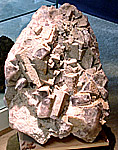For new collectors
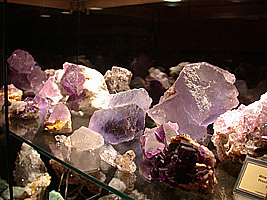
|
Fluorite
has alwas fascinated the humans. Indeed, the large number of colors and
also the diversity of crystallizations make fluorite as an entire part of
a collection. But, your look can go to others minerals...
This page
has not the target to give lessons. But, it only wants to share a
passion for minerals with young collectors. Hesitations due to the
beginning of a collection can appear and it's why we suggest some ideas
that will help you in your search:
|
1)
the constitution of a collection :
It can be made by different ways: you can collect all the minerals, without
restriction (if it's not money), and you can choose your specimens according
your heart during visit of mineralogical stock exchange... It's often how people
begin.
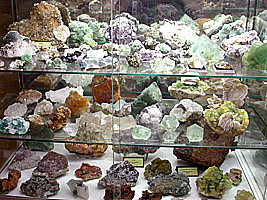
|
Day after
day, month after month, the quantity of specimen increase in your display
cabinet, your signht is refining, your unconscious is making chooices and
is guiding the conscious. So, you take off specimens became unworthy of
interest,, in order to replace them by others.
The wish
of a thematic collection can appear (if it's not done since the beginning).
So, you can collect fluorites, or calcites...etc. It is a thematic based
on one specy, but the choice can also be about a country (England, Brazil...),
see a partcular site (the site of Tsumeb-Namibie) the minerals of the Minas Gerais-Brésil,
...).
The size
of the minerals can also be an other factor. After you got your glass
magnifying until 100x, approximately, your choices will be for very small
samples, not really expensive and in which crystallizations are prefect...
but invisible to human eye.
|
Finally, the
standard "minerals found at home" can be given. You make a collection of
specimens found by yourself... the only problem is that the research is not easy,
because, even if the mineralogical inheritance is impotant in our country, the
access to the sites of minerals is more and more difficult (closing of mines,
private sites...). Foreign countries still leave a door opened on new
discoveries...
To conclude this
paragraph, we have to say that having pieces with a good quality requires a lot
of patience, contacts, discussions ...and personal research.
2) An help ?
A minimum of knowledge is necessary in order to have a presentiment of the
piece that will enrich your collection. You have not to be a senior specialist.
Yet, in the first time,it's not useless to be with a lover more
experimented.
|
3)
Trust your instinct :
The nicest piece of your collection is not the more expensive, but
certainly, this one you like the most. Only famed specialists invest in a
mineral collection. Most of the collectors live their passion,, or their
pleasure by getting "the specimen" for which they have an heart click.
Visiting collections (private or museum collections) can only enrich...
|
|
4) Attraction for the "new"...
It's not a reason to be abused when you see a new unique specimen. Allright, a
nice specimen has a commercial value but you have not to pay any price. It is
probable that other minerals with the same origine will appear during the next
months...so, patience can pay in some case. Only the chance then the routine
will guide you.
In exchange gallery, torbernite specimens from Margabal are presented: during
the discovery of these cristallizations, prices increased. Now, they are
decreasing. And we can think that the fall will go on... It will be possible if
new discoveries of specimens with a such quality were found. However, due
to the building site, the difficulty for the progress of the works... the
probability is very low. Yet, chinese green fluuorite specimens can see their
price increase from a stand to another one: mines are still in activity and
discoveries take place each day... But what about the specimen of exception...?
s
Stock exchanges
can give you an idea of the commercial value of fluorite that can enrich your
collection. The most of the time we give an estimation because commercial price
can be naturally higher. A commercial marge is done.
But it exists
exceptions. Lastly, chinese fluorite appeared in different mineralogical stock
exchanges. The most spectacular one had 40cm of diameter, and was composed of
blue crystals, gemmes... and intacts. A real specimen of museum. its price was
about 20 000 euros.
Just one question to ask: shall i buy it and not buy other pieces during x
years, being sure to no see it later? Of course, everything depends on financial
possibilities, but this exemple can be translated for other pieces at a lower
price.
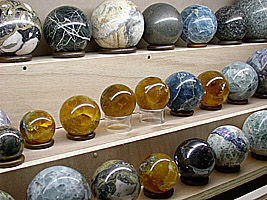
|
5)
Specimens to choose :
We have not to forget that each stone is unique. Consequently, the
estimation cannot be substitued to the specificity of a similar stone: shape,
size, purety, aesthetics and association with others minerals... are
elements that can sometimes change a price in very important ratio. These
standards can refine with time...
Some "purists" will be interested in crystals in which you can
find the shape and the color are disappointing: be careful because you can
have in front of you a systematicist This last one will look for all the
pieces representative of a mine in order to have an exhaustive sight of the
richness of the site (ex: Berbes, asturies - Spain - delivered
cristallizations of fluorite of all qualities: from purple "amethyst", to
the very light pink where the sides are corroded...). |
6)
The litterature about the subject
In spite of fluorite has always interested collectors, the litterature stays
limited in this field.
The "paper"
editions :
Spathfluor.com is not only there in order to represent the book about the mine
and minerals found in Valzergues. It's there in order to insist on the fact that
you will also find for what this fluorite was used.
The BRGM report
of Jean Féraud can also bring multiple knowledges about the subject.
Internet...
:
Numerous are the websites dealing of this nice mineral. Some of them are presents
in the links (selection).
Spathfluor is not only the transcription of a passion, the website
and the book of Valzergues are also windows opened as big as possible on the
wonderful world of minerals and the sharing of knowledge.
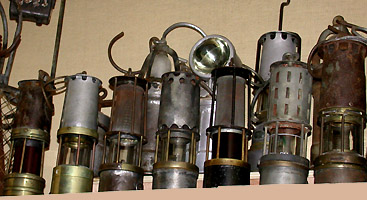
Mineralogy and mining tools are compatible...
|



